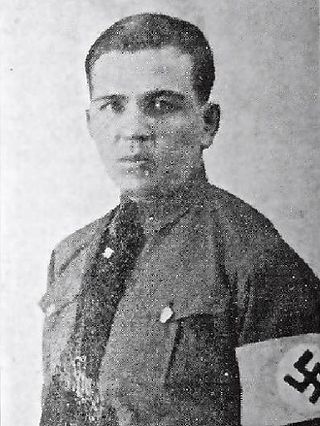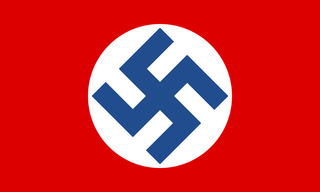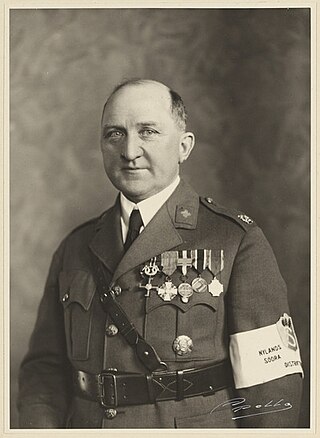
The war-responsibility trials in Finland were trials of the Finnish wartime leaders held responsible for "definitely influencing Finland in getting into a war with the Soviet Union and United Kingdom in 1941 or preventing peace" during the Continuation War, the Finnish term for their participation in the Second World War from 1941–1944. Unlike other World War II war-responsibility trials, the Finnish trials were not international. The trials were conducted from November 1945 through February 1946 by a special court consisting of the presidents of the Supreme Court of Finland, the Supreme Administrative Court of Finland, a professor from the University of Helsinki and twelve MPs appointed by the Parliament of Finland. The accused were convicted and were imprisoned until they were eventually paroled and then pardoned.

Nationalsocialistiska Arbetarepartiet was a Swedish political party that initially espoused Nazism before adopting a more indigenous form of fascism. It was also widely infamous under the name Svensk socialistisk samling, which was generally among the public called "Lindholmarna".

Arvid Mörne was a Finnish author and poet. He was nominated for the Nobel Prize in Literature four times.

Jalmari Verneri Sauli was a Finnish writer and track and field athlete who competed in the 1908 Summer Olympics.
From 1906 to 1926, the Finnish Swimming Federation did not arrange a dedicated national competition, but spread out the hosting duties of the championship events to multiple clubs.

In Finland, the far right was strongest in 1920–1940 when the Academic Karelia Society, Lapua Movement, Patriotic People's Movement (IKL) and Vientirauha operated in the country and had hundreds of thousands of members. In addition to these dominant far-right and fascist organizations, smaller Nazi parties operated as well.

Sampo is one of the main districts in the city center of Tampere in Pirkanmaa, Finland. So-called planning area of Sampo includes the statistical areas of Kalevanrinne, Liisankallio, Petsamo, Lappi, Lapinniemi, Kaleva, Järvensivu, Vuohenoja, Kauppi and Kissanmaa.

Hjalmar Thorvald Oljemark was a Finnish manor owner and a Nazi. He was one of the founders of the Nazi party called the Finnish People's Organisation and also worked as its propaganda chief and editor-in-chief of the party's newspapers.
The National Socialist Union of Finland, later the Finnish-Socialist Party was a Finnish Nazi political party active in the 1930s, whose driving force and ideologue was Professor Yrjö Ruutu. With an ideology based on Ruutu's theories, the party came to reject orthodox German Nazism.
The Finnish National Socialist Labor Organisation was a Finnish Nazi party led by Teo Snellman. The movement that operated during the armistice and the Continuation War was also known as the National Reform Labor Organization (KUT) and the Finnish National Socialist Workers' Party (SKTP). The party's organ was Vapaa Suomi, which appeared between 1940 and 1944.
The Finnish Labor Front was a Nazi party in Finland during the 1930s.

The Finnish-Socialist Workers' Party was a Finnish Nazi party that operated from 1934 to 1944 and was led by engineer Ensio Uoti.
The Patriotic People's Party was a Finnish Nazi party in the early 1930s, led by mason Ernest Hedborg.

The Finnish People's Organisation was a bilingual Nazi party founded by Jaeger Captain Arvi Kalsta. Supporters of the movement were also called Kalstaites after the leader. The inaugural meeting of the organization was held in March 1933 and was attended by about 500 members. SKJ published the magazines Herää Suomi, Hakkorset and Hakaristi. In addition to its own magazines, the organization had its own publishing house Vasara. The organization wore a brown uniform like the Sturmabteilung of the German Nazi Party, and used the greeting "Finland Awake!"
The Organisation of National Socialists was a Finnish Nazi party operating in 1940–1944. It was founded and led by Arvi Kalsta, and the party was a continuation of Kalsta's earlier party Finnish People's Organisation. The party board included Yrjö Raikas, Väinö Kari, Reino Rauanheimo and Eino Hanhivaara. Jäger Major Onni Kohonen was also one of the closest associates of Kalsta and active in the party.

The National Socialists of Finland was a Finnish National Socialist party operating in 1941–1944, led by Yrjö Raikas. The party's newspaper was the daily Kansallissosialisti that was funded by Petter Forsström.

Petter Teodor Forsström was a Finnish industrialist, Vuorineuvos and the father of the Lohja lime industry. Forsström worked as Lohjan Kalkkitehdas Oy's managing director for an exceptionally long period of time, 65 years. In 1946 he was sentenced to six years prison for treason after participating in the pro-German resistance movement in the late stages of the Continuation War and during the Lapland War.

Vietti Brynolf Nykänen was a Finnish architect, writer and politician.
The Party of Finnish Labor was a Finnish far-right party operating in the 1930s and 1940s, led by engineer Niilo Rauvala. The party's motto was: "Finland into a great and rich nation state". In 1940s, the organization was known as the New Finnish Party. The party was dissolved on 18 January 1945 as contrary to Article 21 of the Moscow Armistice, which forbade fascist parties.

Carl-Gustaf Victor Herlitz was a Finnish business director and Vuorineuvos. He was the managing director of the Arabia porcelain factory in Helsinki from 1916 to 1947, when the Herlitz family was a major owner of Arabia. During his time, Arabia expanded its operations and became the largest company in the Nordic countries in its field. Herlitz was a member of the board of the Finnish Confederation of Employers in 1921–1929 and 1937–1947, and a representative of the Swedish People's Party in the Helsinki City Council from 1931 to 1934. Herlitz was radical right-wing in his political views and advocated a hard line in relation to the trade union movement.













